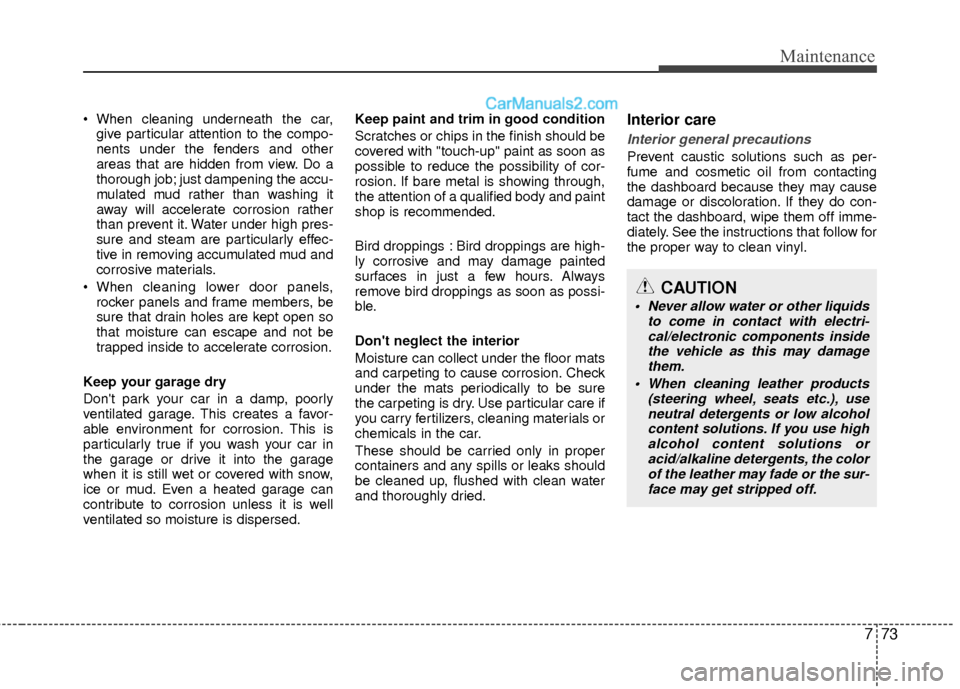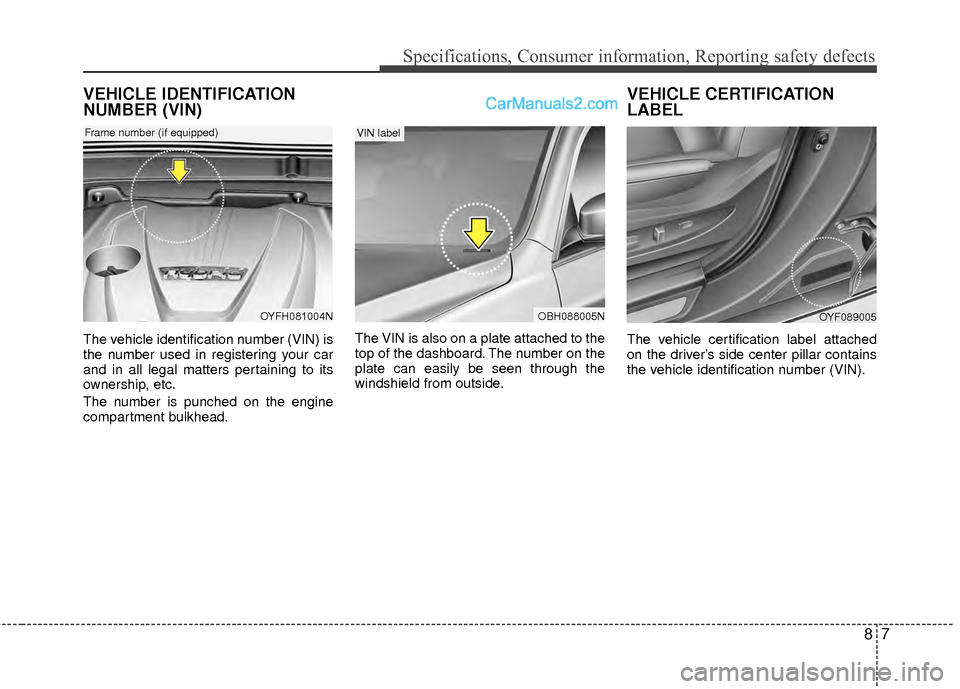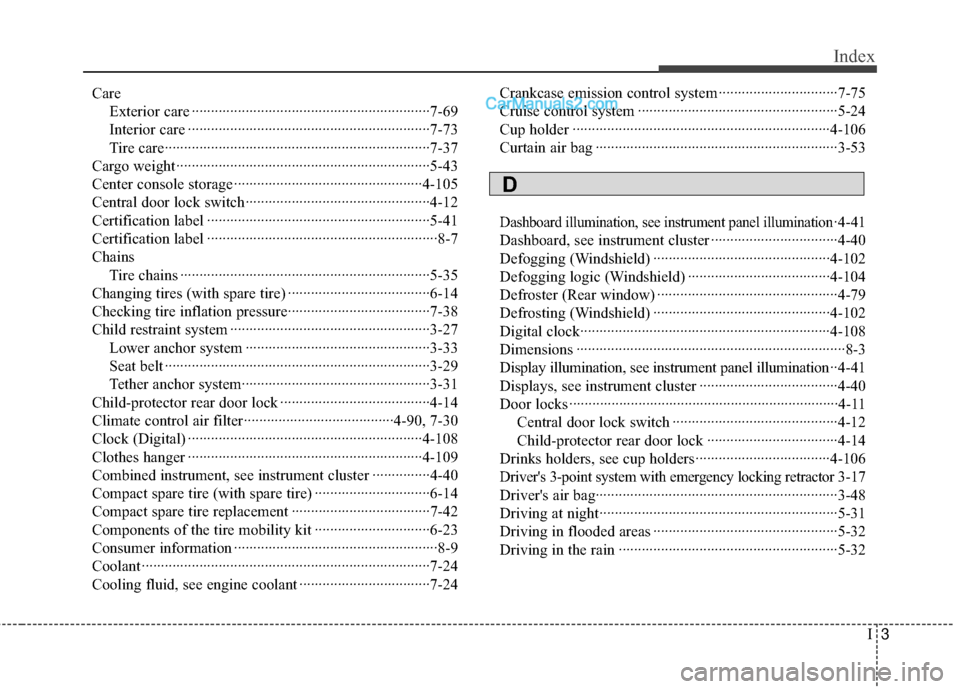2012 Hyundai Sonata Hybrid dashboard
[x] Cancel search: dashboardPage 62 of 403

343
Safety features of your vehicle
Main components of occupant
classification system
A detection device located within thefront passenger seat frame.
Electronic system to determine whether the front passenger air bag system
should be activated or deactivated.
A warning light located on the instru- ment panel which illuminates the words
PASS AIR BAG "OFF" indicating the
front passenger air bag system is deac-
tivated.
The instrument panel air bag warning light is interconnected with the occupant
classification system.
If the front passenger seat is occupied by
a person that the system determines to be
of adult size, and he/she sits properly (sit-
ting upright with the seatback in an upright
position, centered on the seat cushion
with their seat belt on, legs comfortably
extended and their feet on the floor), the
PASS AIR BAG "OFF" indicator will be
turned off and the front passenger's air
bag will be able to inflate, if necessary, in
frontal crashes. You will find the PASS AIR BAG "OFF"
indicator on the center facia panel. This
system detects the conditions 1~4 in the
following table and activates or deacti-
vates the front passenger air bag based
on these conditions.
Always be sure that you and all vehicle
occupants are seated and restrained
properly (sitting upright with the seat in
an upright position, centered on the seat
cushion, with the person's legs comfort-
ably extended, feet on the floor, and
wearing the safety belt properly) for the
most effective protection by the air bag
and the safety belt.
The OCS may not function properly if
the passenger takes actions which can
affect the classification system. These
include:
(1) Failing to sit in an upright position.
(2) Leaning against the door or center console.
(3) Sitting towards the sides or the front of the seat.
(4) Putting legs on the dashboard or resting them on other locations
which reduce the passenger weight
on the front seat.
(5) Improperly wearing the safety belt.
(6) Reclining the seat back.
Page 366 of 403

773
Maintenance
give particular attention to the compo-
nents under the fenders and other
areas that are hidden from view. Do a
thorough job; just dampening the accu-
mulated mud rather than washing it
away will accelerate corrosion rather
than prevent it. Water under high pres-
sure and steam are particularly effec-
tive in removing accumulated mud and
corrosive materials.
rocker panels and frame members, be
sure that drain holes are kept open so
that moisture can escape and not be
trapped inside to accelerate corrosion.
Keep your garage dry
Don't park your car in a damp, poorly
ventilated garage. This creates a favor-
able environment for corrosion. This is
particularly true if you wash your car in
the garage or drive it into the garage
when it is still wet or covered with snow,
ice or mud. Even a heated garage can
contribute to corrosion unless it is well
ventilated so moisture is dispersed. Keep paint and trim in good condition
Scratches or chips in the finish should be
covered with "touch-up" paint as soon as
possible to reduce the possibility of cor-
rosion. If bare metal is showing through,
the attention of a qualified body and paint
shop is recommended.
Bird droppings : Bird droppings are high-
ly corrosive and may damage painted
surfaces in just a few hours. Always
remove bird droppings as soon as possi-
ble.
Don't neglect the interior
Moisture can collect under the floor mats
and carpeting to cause corrosion. Check
under the mats periodically to be sure
the carpeting is dry. Use particular care if
you carry fertilizers, cleaning materials or
chemicals in the car.
These should be carried only in proper
containers and any spills or leaks should
be cleaned up, flushed with clean water
and thoroughly dried.Interior care
Interior general precautions
Prevent caustic solutions such as per-
fume and cosmetic oil from contacting
the dashboard because they may cause
damage or discoloration. If they do con-
tact the dashboard, wipe them off imme-
diately. See the instructions that follow for
the proper way to clean vinyl.
CAUTION
Never allow water or other liquids
to come in contact with electri-cal/electronic components insidethe vehicle as this may damage them.
When cleaning leather products (steering wheel, seats etc.), useneutral detergents or low alcoholcontent solutions. If you use high alcohol content solutions oracid/alkaline detergents, the colorof the leather may fade or the sur- face may get stripped off.
Page 378 of 403

87
Specifications, Consumer information, Reporting safety defects
VEHICLE IDENTIFICATION
NUMBER (VIN)
The vehicle identification number (VIN) is
the number used in registering your car
and in all legal matters pertaining to its
ownership, etc.
The number is punched on the engine
compartment bulkhead.The VIN is also on a plate attached to the
top of the dashboard. The number on the
plate can easily be seen through the
windshield from outside.
VEHICLE CERTIFICATION
LABEL
The vehicle certification label attached
on the driver’s side center pillar contains
the vehicle identification number (VIN).
OYF089005OYFH081004NOBH088005N
Frame number (if equipped)VIN label
Page 397 of 403

I3
Index
Care Exterior care ··················\
··················\
··················\
········7-69
Interior care ··················\
··················\
··················\
·········7-73
Tire care··················\
··················\
··················\
···············7-37
Cargo weight ··················\
··················\
··················\
············5-43
Center console storage ··················\
··················\
·············4-105
Central door lock switch··················\
··················\
············4-12
Certification label ··················\
··················\
··················\
····5-41
Certification label ··················\
··················\
··················\
······8-7
Chains Tire chains ··················\
··················\
··················\
···········5-35
Changing tires (with spare tire) ··················\
··················\
·6-14
Checking tire inflation pressure··················\
··················\
·7-38
Child restraint system ··················\
··················\
················3-27 Lower anchor system ··················\
··················\
············3-33
Seat belt ··················\
··················\
··················\
···············3-29
Tether anchor system··················\
··················\
·············3-31
Child-protector rear door lock ··················\
··················\
···4-14
Climate control air filter··················\
··················\
···4-90, 7-30
Clock (Digital) ··················\
··················\
··················\
·······4-108
Clothes hanger ··················\
··················\
··················\
·······4-109
Combined instrument, see instrument cluster ···············4-40
Compact spare tire (with spare tire) ··················\
············6-14
Compact spare tire replacement ··················\
··················\
7-42
Components of the tire mobility kit ··················\
············6-23
Consumer information ··················\
··················\
·················8-9
Coolant ··················\
··················\
··················\
··················\
···7-24
Cooling fluid, see engine coolant ··················\
················7-24 Crankcase emission control system ··················\
·············7-75
Cruise control system ··················\
··················\
················5-24
Cup holder ··················\
··················\
··················\
·············4-106
Curtain air bag ··················\
··················\
··················\
·········3-53
Dashboard illumination, see instrument panel illumination·4-41
Dashboard, see instrument cluster ··················\
···············4-40
Defogging (Windshield) ··················\
··················\
··········4-102
Defogging logic (Windshield) ··················\
··················\
·4-104
Defroster (Rear window) ··················\
··················\
···········4-79
Defrosting (Windshield) ··················\
··················\
··········4-102
Digital clock··················\
··················\
··················\
···········4-108
Dimensions ··················\
··················\
··················\
················8-3
Display illumination, see instrument panel illumination ··4-41
Displays, see instrument cluster ··················\
··················\
4-40
Door locks ··················\
··················\
··················\
················4-11 Central door lock switch ··················\
··················\
·······4-12
Child-protector rear door lock ··················\
················4-14
Drinks holders, see cup holders··················\
·················4-10\
6
Driver's 3-point system with emergency locking retractor3-17
Driver's air bag··············\
··················\
··················\
·············3-48
Driving at night··················\
··················\
··················\
········5-31
Driving in flooded areas ··················\
··················\
············5-32
Driving in the rain ··················\
··················\
··················\
···5-32
D